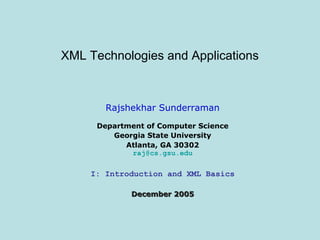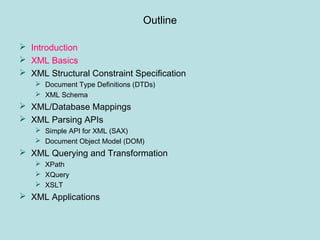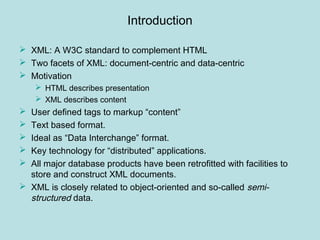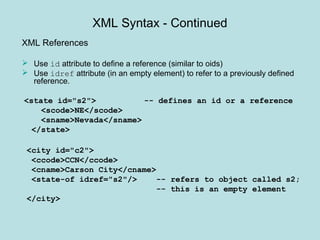Xml basics concepts
- 1. XML Technologies and Applications Rajshekhar Sunderraman Department of Computer Science Georgia State University Atlanta, GA 30302 raj@cs.gsu.edu I: Introduction and XML Basics December 2005December 2005
- 2. Outline ÔÉò Introduction ÔÉò XML Basics ÔÉò XML Structural Constraint Specification ÔÉò Document Type Definitions (DTDs) ÔÉò XML Schema ÔÉò XML/Database Mappings ÔÉò XML Parsing APIs ÔÉò Simple API for XML (SAX) ÔÉò Document Object Model (DOM) ÔÉò XML Querying and Transformation ÔÉò XPath ÔÉò XQuery ÔÉò XSLT ÔÉò XML Applications
- 3. Introduction  XML: A W3C standard to complement HTML  Two facets of XML: document-centric and data-centric  Motivation  HTML describes presentation  XML describes content  User defined tags to markup “content”  Text based format.  Ideal as “Data Interchange” format.  Key technology for “distributed” applications.  All major database products have been retrofitted with facilities to store and construct XML documents.  XML is closely related to object-oriented and so-called semi- structured data.
- 4. Semistructured Data An HTML document (student list) to be displayed on the Web <dt>Name: John Doe <dd>Id: s111111111 <dd>Address: <ul> <li>Number: 123</li> <li>Street: Main</li> </ul> </dt> <dt>Name: Joe Public <dd>Id: s222222222 … … … … </dt> HTML does not distinguish between attributes and values
- 5. Semistructured Data (cont’d.)  To make the previous student list suitable for machine consumption on the Web, it should have the following characteristics  Be object-like  Be schemalessschemaless (not guaranteed to conform exactly to any schema, but different objects have some commonality among themselves.  Be self-describingself-describing (some schema-like information, like attribute names, is part of data itself)  Data with these characteristics are referred to as semistructured.
- 6. Semi-structured Data Model  Set of label-value pairs. {name: "Alan", tel: 2157786, email: “a@abc.com” }  The values themselves may be structures {name: {first: “Alan”, last: “Black”}, tel: 2157786, email: “a@abc.com” } name tel email “Alan” 2157786 “a@abc.com” name tel email 2157786 “a@abc.com” lastfirst “Alan” “Black” Graph Model: Nodes represent objects connected by labeled edges to values
- 7. Semi-structured Data Model  Duplicate labels allowed {name: "Alan", tel: 2157786, tel: 2498762"}  The syntax is easily generalized to describe sets of objects {person: {name: “Alan”,tel: 2157786,email: “a@abc.com”} person: {name: “Sara”,tel: 2136877,email: “sara@abc.com”} person: {name: “Fred”,tel: 7786312,email: “fred@abc.com”} }  All objects within a set need not have the same structure {person:{name: “Alan”,tel: 2157786,email: “a@abc.com”}, person:{name: {first: “Sara”,last: “Black”},email: “s@abc.com”}, person:{name: “Fred”, tel: 7786312, height: 168} }
- 8. Semi-structured Data Model  Relational Data is easily represented {r1: {row: {a: a1, b: b1, c: c1}, {row: {a: a2, b: b2, c: c2}}, r2: {row: {c: c2, d: d2}, row: {c: c3, d: d3}, row: {c: c4, d: d4}} }  Object-oriented data is also naturally represented (each node has a unique object id, either explicitly mentioned or system generated) {person: &o1{name: “Mary”, age: 45, child: &o2, child: &o3}, person: &o2{name: “John”, age: 17, relatives: {mother: &o1, sister: &o3}}, person: &o3{name: “Jane”, country: “Canada”, mother: &o1} }
- 9. Semi-structured Data Model ÔÉò Formal syntax for semi-structured data model <ssd-expr> ::== <value> | oid <value> | oid <value> ::== atomicvalue | <complexvalue> <complexvalue> ::== { label:<ssd-expr>, ..., label:<ssd-expr> } ÔÉò An oid value is said to be DEFINED if it appears before a value; otherwise it is said to be USED ÔÉò An ssd-expression is CONSISTENT if ÔÉò An oid is defined at most once and ÔÉò If an oid is used, it must also be defined. ÔÉò A flexible and powerful data model that is capable of representing data that does not have to follow the strict rules of databases.
- 10. What is Self-describing Data? Non-self-describing (relational, object-oriented): Data part: (#12345, [“Students”, {[“John”, s111111111, [123,”Main St”]], [“Joe”, s222222222, [321, “Pine St”]] } ] ) Schema part: PersonListPersonList[ ListName: String, Contents: [ Name: String, Id: String, Address: [Number: Integer, Street: String] ] ]
- 11. What is Self-Describing Data? (contd.)  Self-describing:  Attribute names embedded in the data itself, but are distinguished from values  Doesn’t need schema to figure out what is what (but schema might be useful nonetheless) (#12345, [ListName: “Students”, Contents: { [ Name: “John Doe”, Id: “s111111111”, Address: [Number: 123, Street: “Main St.”] ] , [Name: “Joe Public”, Id: “s222222222”, Address: [Number: 321, Street: “Pine St.”] ] } ] )
- 12. XML – The De Facto Standard for Semi-structured Data  XML: eXXtensible MMarkup LLanguage  Suitable for semi-structured data and has become a standard  Used to describe content rather than presentation  Differs from HTML in following ways  New tags may be defined at will by the author of the document (extensible)  No semantics behind tags. For instance, HTML’s <table>…<table>… </table></table> means: render contents as a table; in XML: doesn’t mean anything special.  Structures may be nested arbitrarily  XML document may contain an optional schema that describes its structure  Intolerant to bugs; Browsers will render buggy HTML pages but XML processors will reject ill-formed XML documents.
- 13. XML Syntax XML Elements element: piece of text bounded by user-defined matching tags: <person> <name>Alan</name> <age>42</age> <email>agb@abc.com</email> </person> Note: ÔÉò Element includes the start and end tag ÔÉò No quotation marks around strings; XML treats all data as text. This is referred to as PCDATA (Parsed Character Data). ÔÉò Empty elements: <married></married> can be abbreviated to <married/>
- 14. XML Syntax - Continued Collections are expressed using repeated structures. Ex. The collection of all persons on the 4th floor: <table> <description>People on the 4th floor</description> <people> <person> <name>Alan</name><age>42</age<<email>agb@abc.com</email> </person> <person> <name>Patsy</name><age>36</age><email>ptn@abc.com</email> </person> <person> <name>Ryan</name><age>58</age><email>rgz@abc.com</email> </person> </people> </table>
- 15. XML Syntax - Continued XML Attributes • Attributes define some properties of elements • Expressed as a name-value pairs <product> <name language="French">trompette six trous</name> <price currency="Euro">420.12</price> <address format="XLB56" language="French"> <street>31 rue Croix-Bosset</street> <zip>92310</zip> <city>Sevres</city> <country>France</country> </address> </product> • As with tags, user may define any number of attributes • Attribute values must be enclosed within quotation marks.
- 16. XML Syntax - Continued Attributes vs Elements ÔÉò A given attribute can occur only once within a tag; Its value is always a string ÔÉò On the other hand tags defining elements/sub-elements can repeat any number of times and their values may be string data or sub-elements ÔÉò Same data may be encoded using attributes or elements or a combination of the two <person name="Alan" age="42"> <email>agb@abc.com</email> </person> or <person name="Alan"> <age>42</age> <email>agb@abc.com</email> </person>
- 17. XML Syntax - Continued XML References ÔÉò Use id attribute to define a reference (similar to oids) ÔÉò Use idref attribute (in an empty element) to refer to a previously defined reference. <state id="s2"> -- defines an id or a reference <scode>NE</scode> <sname>Nevada</sname> </state> <city id="c2"> <ccode>CCN</ccode> <cname>Carson City</cname> <state-of idref="s2"/> -- refers to object called s2; -- this is an empty element </city>
- 18. XML Syntax - Continued Mixing Elements and Text ÔÉò XML allows us to mix PCDATA and sub-elements within an element. <person> This is my best friend <name>Alan</name> <age>42</age> I am not sure of the following email <email>agb@abc.com</email> </person> ÔÉò This seems un-natural from a database perspective, but from a document perspective, this is quite natural!
- 19. XML Syntax - Continued Order • The semi-structured data model is based on unordered collections, whereas XML is ordered. The following two pieces of semi-structured data are equivalent: person: {fname: "John", lname: "Smith:} person: {lname: "Smith", fname: "John"} but the following two XML data are not: <person><fname>John</fname><lname>Smith</lname></person> <person><lname>Smith></lname><fname>John</fname></person> • To make matters worse, attributes are NOT ordered in XML; Following two are equivalent: <person fname="John" lname="Smith"/> <person lname="Smith" fname="John"/>
- 20. XML Syntax - Continued Other XML Constructs ÔÉò Comments: <!-- this is a comment --> ÔÉò Processing Instruction (PI): <?xml version="1.0"?> <?xml-stylesheet type="text/xsl" href="classes.xsl"?> Such instructions are passed on to applications that process XML files. ÔÉò CDATA (Character Data): used to write escape blocks containing text that otherwise would be considered markup: <![CDATA[<start>this is not an element</start>]]> ÔÉò Entities: < stands for <
- 21. Well-Formed XML Documents ÔÉò An XML document is well-formed if ÔÉò Tags are syntactically correct ÔÉò Every tag has an end tag ÔÉò Tags are properly nested ÔÉò There is a root tag ÔÉò A start tag does not have two occurrences of the same attribute ÔÉò An XML document must be well-formed before it can be processed. ÔÉò A well-formed XML document will parse into a node-labeled tree
- 22. <?xml version=“1.0” ?> <PersonList Type=“Student” Date=“2002-02-02” > <Title Value=“Student List” /> <Person> … … … </Person> <Person> … … … </Person> </PersonList> • Elements are nested • Root element contains all others Element (or tag) names Terminology elements RootRootelement Empty element attributes
- 23. More Terminology <Person Name = “John” Id = “s111111111”> John is a nice fellow <Address> <Number>21</Number> <Street>Main St.</Street> </Address> … … … </Person> Opening tag Closing tag: What is open must be closed Nested element, child of PersonPerson Parent of AddressAddress, Ancestor of numbernumber “standalone” text, not very useful as data, non-uniform Child of AddressAddress, Descendant of PersonPerson ContentofPersonPerson
- 24. XML Data Model person name emailtel tel Bart Simpson 02–4447777 051–011022 bart@tau.ac.il  Document Object Model (DOM) – DOM Tree  Leaves are either empty or contain PCDATA  Unlike ssd tree model, nodes are labeled with tags.









![What is Self-describing Data?
Non-self-describing (relational, object-oriented):
Data part:
(#12345, [“Students”, {[“John”, s111111111, [123,”Main St”]],
[“Joe”, s222222222, [321, “Pine St”]] }
] )
Schema part:
PersonListPersonList[ ListName: String,
Contents: [ Name: String,
Id: String,
Address: [Number: Integer, Street: String] ]
]](https://image.slidesharecdn.com/xml-basics-140416030318-phpapp02/85/Xml-basics-concepts-10-320.jpg)
![What is Self-Describing Data? (contd.)
ÔÉò Self-describing:
ÔÉò Attribute names embedded in the data itself, but are distinguished
from values
 Doesn’t need schema to figure out what is what (but schema might
be useful nonetheless)
(#12345,
[ListName: “Students”,
Contents: { [ Name: “John Doe”,
Id: “s111111111”,
Address: [Number: 123, Street: “Main St.”] ] ,
[Name: “Joe Public”,
Id: “s222222222”,
Address: [Number: 321, Street: “Pine St.”] ] }
] )](https://image.slidesharecdn.com/xml-basics-140416030318-phpapp02/85/Xml-basics-concepts-11-320.jpg)








![XML Syntax - Continued
Other XML Constructs
ÔÉò Comments:
<!-- this is a comment -->
ÔÉò Processing Instruction (PI):
<?xml version="1.0"?>
<?xml-stylesheet type="text/xsl" href="classes.xsl"?>
Such instructions are passed on to applications that process XML
files.
ÔÉò CDATA (Character Data): used to write escape blocks containing
text that otherwise would be considered markup:
<![CDATA[<start>this is not an element</start>]]>
ÔÉò Entities: < stands for <](https://image.slidesharecdn.com/xml-basics-140416030318-phpapp02/85/Xml-basics-concepts-20-320.jpg)



